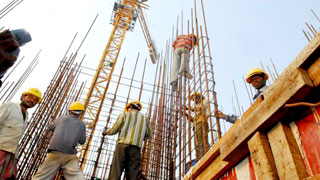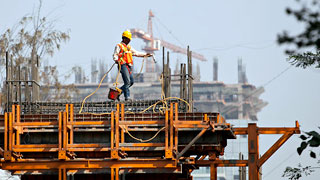Shortage of talent hurting realty growth
- 6th May 2015
- 2926
- 0

A recent report by the National Skill Development Corporation (NSDC) states that India will need approx a 76.5mn strong workforce to drive its construction and real estate sectors - the largest incremental human resource requirement from 2013-2022 among all the 24 sectors studied by the agency.
As per the findings, the demand for skilled labour in the realty and construction sector is likely to rise due to a growing demand for affordable housing which is expected to touch 38mn by 2030.
It further points to various other contributing factors like the rapid growth in IT and financial services across several Tier II and Tier III cities, increased investments into key infra sectors like power, ports, civil aviation, roads and railways which are likely to touch US$1 trillion (during the 12th Plan period) and a expected rise in demand for warehousing facilities in major cities hosting food processing companies. The report further adds that despite being the second largest employment provider in the country after agriculture, the domestic construction industry continued to be highly unorganised employing migrants for short durations with more than 36 percent of the estimated 15.2mn short duration out migrants being employed in the construction domain alone.
The report further adds that despite being the second largest employment provider in the country after agriculture, the domestic construction industry continued to be highly unorganised employing migrants for short durations with more than 36 percent of the estimated 15.2mn short duration out migrants being employed in the construction domain alone.
The NSDC findings also found that in excess of 97 percent of individuals between the age groups of 15 and 65 had no exposure whatsoever to any form of industrial training, highlighting the pressing need to expand the reach of training providers, set up models and specialised industrial institutes with the capability to scale.
Commenting on this, Dilip Chenoy, MD & CEO, NSDC admitted that there was a huge manpower requirement that the industry had to cater to. "We need manpower, proficient with excellent skills on technical abilities. The industry and the government both need to pay special attention on this segment of workforce. Over the last 5 years, we have trained more than 5mn people with more than 15, 376, 57 already working in the industry," he said. The construction sector is the largest contributor to the central exchequer and creates more than 45 million jobs directly or indirectly among various classes of individuals in the country. However more than 80 per cent of those employed in the building and construction sector comprise of a minimally skilled workforce.
The construction sector is the largest contributor to the central exchequer and creates more than 45 million jobs directly or indirectly among various classes of individuals in the country. However more than 80 per cent of those employed in the building and construction sector comprise of a minimally skilled workforce.
The report also states that a severe shortage of talent in the industry was a long-term problem which continued to increase both project costs and risks involved, with the existing training schemes being unable to meet the demand from the large number of unskilled labour.
Moreover, the existing education system in the country was also not delivering the required number of skilled professionals across specialised fields like project management, surveying, contract management and engineering.
Between 2000 and 2013, the building and construction sector in India attracted approx US$40,399mn as Foreign Direct Investment with the numbers expected to touch an estimated US$180bn by 2020. The sector grew at a CAGR of 9.42 percent between 2003-04 and 2012-13. Capital investments are also expected to increase from the present US$651bn (in 2012-13) to an estimated US$1181bn by 2019-20.
The sector grew at a CAGR of 9.42 percent between 2003-04 and 2012-13. Capital investments are also expected to increase from the present US$651bn (in 2012-13) to an estimated US$1181bn by 2019-20.
On the employment front, lower level skilled personnel like technicians and construction foremen have witnessed the maximum growth of approx 95 percent between 2005 and 2011 followed by unskilled labour at about 34 percent.
The report also highlights the fact that only a mere 9.8mn of the total 32mn construction workers in the country are registered. Smaller states and Union territories like Tripura, Manipur and Lakshadweep were the front-runners when it came to employing the highest number of registered workers in the construction domain.
While there seems to be no immediate solution to the crippling shortage of skilled manpower to both the construction and real estate domains, the report has once again served to highlight the long-standing issue and the need to create the required infrastructure to ensure that the trained personnel needs of the industry are met in full.



Comments
Add Your Comment
Thank you, for commenting !!
Your comment is under moderation...
Keep reading other articles